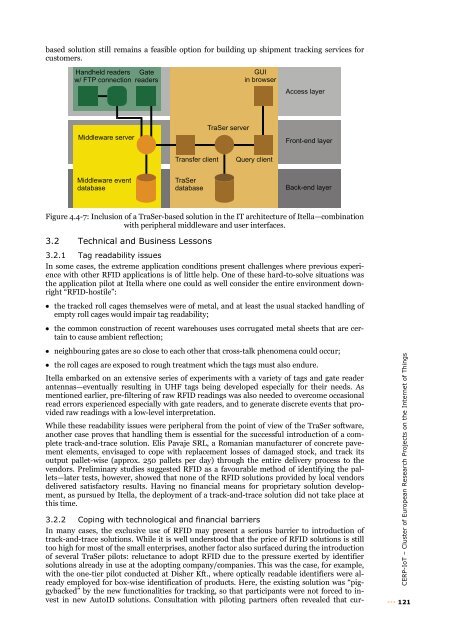Vision and Challenges for Realising the Internet of Things
Vision and Challenges for Realising the Internet of Things
Vision and Challenges for Realising the Internet of Things
You also want an ePaper? Increase the reach of your titles
YUMPU automatically turns print PDFs into web optimized ePapers that Google loves.
ased solution still remains a feasible option <strong>for</strong> building up shipment tracking services <strong>for</strong><br />
customers.<br />
Figure 4.4-7: Inclusion <strong>of</strong> a TraSer-based solution in <strong>the</strong> IT architecture <strong>of</strong> Itella—combination<br />
with peripheral middleware <strong>and</strong> user interfaces.<br />
3.2 Technical <strong>and</strong> Business Lessons<br />
3.2.1 Tag readability issues<br />
In some cases, <strong>the</strong> extreme application conditions present challenges where previous experience<br />
with o<strong>the</strong>r RFID applications is <strong>of</strong> little help. One <strong>of</strong> <strong>the</strong>se hard-to-solve situations was<br />
<strong>the</strong> application pilot at Itella where one could as well consider <strong>the</strong> entire environment downright<br />
“RFID-hostile”:<br />
<strong>the</strong> tracked roll cages <strong>the</strong>mselves were <strong>of</strong> metal, <strong>and</strong> at least <strong>the</strong> usual stacked h<strong>and</strong>ling <strong>of</strong><br />
empty roll cages would impair tag readability;<br />
<strong>the</strong> common construction <strong>of</strong> recent warehouses uses corrugated metal sheets that are certain<br />
to cause ambient reflection;<br />
neighbouring gates are so close to each o<strong>the</strong>r that cross-talk phenomena could occur;<br />
<strong>the</strong> roll cages are exposed to rough treatment which <strong>the</strong> tags must also endure.<br />
Itella embarked on an extensive series <strong>of</strong> experiments with a variety <strong>of</strong> tags <strong>and</strong> gate reader<br />
antennas—eventually resulting in UHF tags being developed especially <strong>for</strong> <strong>the</strong>ir needs. As<br />
mentioned earlier, pre-filtering <strong>of</strong> raw RFID readings was also needed to overcome occasional<br />
read errors experienced especially with gate readers, <strong>and</strong> to generate discrete events that provided<br />
raw readings with a low-level interpretation.<br />
While <strong>the</strong>se readability issues were peripheral from <strong>the</strong> point <strong>of</strong> view <strong>of</strong> <strong>the</strong> TraSer s<strong>of</strong>tware,<br />
ano<strong>the</strong>r case proves that h<strong>and</strong>ling <strong>the</strong>m is essential <strong>for</strong> <strong>the</strong> successful introduction <strong>of</strong> a complete<br />
track-<strong>and</strong>-trace solution. Elis Pavaje SRL, a Romanian manufacturer <strong>of</strong> concrete pavement<br />
elements, envisaged to cope with replacement losses <strong>of</strong> damaged stock, <strong>and</strong> track its<br />
output pallet-wise (approx. 250 pallets per day) through <strong>the</strong> entire delivery process to <strong>the</strong><br />
vendors. Preliminary studies suggested RFID as a favourable method <strong>of</strong> identifying <strong>the</strong> pallets—later<br />
tests, however, showed that none <strong>of</strong> <strong>the</strong> RFID solutions provided by local vendors<br />
delivered satisfactory results. Having no financial means <strong>for</strong> proprietary solution development,<br />
as pursued by Itella, <strong>the</strong> deployment <strong>of</strong> a track-<strong>and</strong>-trace solution did not take place at<br />
this time.<br />
3.2.2 Coping with technological <strong>and</strong> financial barriers<br />
In many cases, <strong>the</strong> exclusive use <strong>of</strong> RFID may present a serious barrier to introduction <strong>of</strong><br />
track-<strong>and</strong>-trace solutions. While it is well understood that <strong>the</strong> price <strong>of</strong> RFID solutions is still<br />
too high <strong>for</strong> most <strong>of</strong> <strong>the</strong> small enterprises, ano<strong>the</strong>r factor also surfaced during <strong>the</strong> introduction<br />
<strong>of</strong> several TraSer pilots: reluctance to adopt RFID due to <strong>the</strong> pressure exerted by identifier<br />
solutions already in use at <strong>the</strong> adopting company/companies. This was <strong>the</strong> case, <strong>for</strong> example,<br />
with <strong>the</strong> one-tier pilot conducted at Disher Kft., where optically readable identifiers were already<br />
employed <strong>for</strong> box-wise identification <strong>of</strong> products. Here, <strong>the</strong> existing solution was “piggybacked”<br />
by <strong>the</strong> new functionalities <strong>for</strong> tracking, so that participants were not <strong>for</strong>ced to invest<br />
in new AutoID solutions. Consultation with piloting partners <strong>of</strong>ten revealed that cur-<br />
CERP-IoT – Cluster <strong>of</strong> European Research Projects on <strong>the</strong> <strong>Internet</strong> <strong>of</strong> <strong>Things</strong><br />
121
















